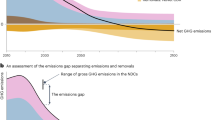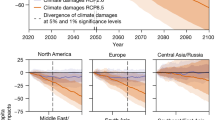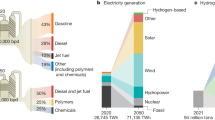Abstract
The combustion of fossil fuels produces emissions of the long-lived greenhouse gas carbon dioxide and of short-lived pollutants, including sulfur dioxide, that contribute to the formation of atmospheric aerosols1. Atmospheric aerosols can cool the climate, masking some of the warming effect that results from the emission of greenhouse gases1. However, aerosol particulates are highly toxic when inhaled, leading to millions of premature deaths per year2,3. The phasing out of unabated fossil-fuel combustion will therefore provide health benefits, but will also reduce the extent to which the warming induced by greenhouse gases is masked by aerosols. Because aerosol levels respond much more rapidly to changes in emissions relative to carbon dioxide, large near-term increases in the magnitude and rate of climate warming are predicted in many idealized studies that typically assume an instantaneous removal of all anthropogenic or fossil-fuel-related emissions1,4,5,6,7,8,9. Here we show that more realistic modelling scenarios do not produce a substantial near-term increase in either the magnitude or the rate of warming, and in fact can lead to a decrease in warming rates within two decades of the start of the fossil-fuel phase-out. Accounting for the time required to transform power generation, industry and transportation leads to gradually increasing and largely offsetting climate impacts of carbon dioxide and sulfur dioxide, with the rate of warming further slowed by reductions in fossil-methane emissions. Our results indicate that even the most aggressive plausible transition to a clean-energy society provides benefits for climate change mitigation and air quality at essentially all decadal to centennial timescales.
This is a preview of subscription content, access via your institution
Access options
Access Nature and 54 other Nature Portfolio journals
Get Nature+, our best-value online-access subscription
$29.99 / 30 days
cancel any time
Subscribe to this journal
Receive 51 print issues and online access
$199.00 per year
only $3.90 per issue
Buy this article
- Purchase on Springer Link
- Instant access to full article PDF
Prices may be subject to local taxes which are calculated during checkout



Similar content being viewed by others
Data availability
All data used in this study is available at the Integrated Assessment Modelling Consortium’s 1.5 °C Scenario Explorer hosted by IIASA at https://data.ene.iiasa.ac.at/iamc-1.5c-explorer/. FaIR v1.3.6 is available from https://doi.org/10.5281/zenodo.1549342.
Code availability
Code used in this study is available from https://doi.org/10.5281/zenodo.3383064.
References
Myhre, G. et al. in Climate Change 2013: The Physical Science Basis (eds Stocker, T. F. et al.) (Cambridge Univ. Press, 2013).
Cohen, A. J. et al. Estimates and 25-year trends of the global burden of disease attributable to ambient air pollution: an analysis of data from the Global Burden of Diseases Study 2015. Lancet 389, 1907–1918 (2017).
Butt, E. W. et al. Global and regional trends in particulate air pollution and attributable health burden over the past 50 years. Environ. Res. Lett. 12, 104017 (2017).
Samset, B. H. et al. Climate impacts from a removal of anthropogenic aerosol emissions. Geophys. Res. Lett. 45, 1020–1029 (2018).
Raes, F. & Seinfeld, J. H. New directions: climate change and air pollution abatement: a bumpy road. Atmos. Environ. 43, 5132–5133 (2009).
Andreae, M. O., Jones, C. D. & Cox, P. M. Strong present-day aerosol cooling implies a hot future. Nature 435, 1187–1190 (2005).
Li, B. et al. The contribution of China’s emissions to global climate forcing. Nature 531, 357–361 (2016).
Arneth, A., Unger, N., Kulmala, M. & Andreae, M. O. Clean the air, heat the planet? Science 326, 672–673 (2009).
Lelieveld, J., Klingmüller, K., Pozzer, A., Burnett, R. T., Haines, A. & Ramanathan, V. Effects of fossil fuel and total anthropogenic emission removal on public health and climate. Proc. Natl Acad. Sci. USA 116, 7192–7197 (2019).
Kloster, S. et al. A GCM study of future climate response to aerosol pollution reductions. Clim. Dyn. 34, 1177–1194 (2010).
Schellnhuber, H. J. Global warming: stop worrying, start panicking? Proc. Natl Acad. Sci. USA 105, 14239–14240 (2008).
Ramanathan, V. & Feng, Y. On avoiding dangerous anthropogenic interference with the climate system: formidable challenges ahead. Proc. Natl Acad. Sci. USA 105, 14245–14250 (2008).
Brasseur, G. P. & Roeckner, E. Impact of improved air quality on the future evolution of climate. Geophys. Res. Lett. 32, L23704 (2005).
Collins, M. et al. in Climate Change 2013: The Physical Science Basis (eds Stocker, T. F. et al.) (Cambridge Univ. Press, 2013).
Matthews, H. D. & Zickfeld, K. Climate response to zeroed emissions of greenhouse gases and aerosols. Nat. Clim. Change 2, 338–341 (2012).
Hare, B. & Meinshausen, M. How much warming are we committed to and how much can be avoided? Clim. Change 75, 111–149 (2006).
Smith, C. J. et al. Current fossil fuel infrastructure does not yet commit us to 1.5 °C warming. Nat. Commun. 10, 101 (2019).
Hienola, A. et al. The impact of aerosol emissions on the 1.5 degrees C pathways. Environ. Res. Lett. 13 https://doi.org/10.1088/1748-9326/aab1b2 (2018).
Fitzpatrick, B. Scrubbing aerosol particles from the atmosphere ‘a Faustian bargain,’ study finds. National Post https://nationalpost.com/news/world/scrubbing-aerosol-particles-from-the-atmosphere-a-faustian-bargain-study-finds (2018).
Rogelj, J. et al. in Global Warming of 1.5 °C (eds Masson-Delmotte, V. et al.) (Cambridge Univ. Press, 2018).
de Coninck, H. et al. in Global Warming of 1.5 °C (eds Masson-Delmotte, V. et al.) (Cambridge Univ. Press, 2018).
Haegel, N. M. et al. Terawatt-scale photovoltaics: trajectories and challenges. Science 356, 141–143 (2017).
Smith, C. J. et al. FAIR v1.3: a simple emissions-based impulse response and carbon cycle model. Geosci. Model Dev. 11, 2273–2297 (2018).
Millar, R. J., Nicholls, Z. R., Friedlingstein, P. & Allen, M. R. A modified impulse-response representation of the global near-surface air temperature and atmospheric concentration response to carbon dioxide emissions. Atmos. Chem. Phys. 2017, 7213–7228 (2017).
Philipona, R., Behrens, K. & Ruckstuhl, C. How declining aerosols and rising greenhouse gases forced rapid warming in Europe since the 1980s. Geophys. Res. Lett. 36, L02806 (2009).
Leibensperger, E. et al. Climatic effects of 1950–2050 changes in US anthropogenic aerosols—Part 2: climate response. Atmos. Chem. Phys. 12, 3349–3362 (2012).
Zheng, B. et al. Trends in China’s anthropogenic emissions since 2010 as the consequence of clean air actions. Atmos. Chem. Phys. 18, 14095–14111 (2018).
Silva, R. A. et al. The effect of future ambient air pollution on human premature mortality to 2100 using output from the ACCMIP model ensemble. Atmos. Chem. Phys. 16, 9847–9862 (2016).
Shindell, D., Faluvegi, G., Seltzer, K. & Shindell, C. Quantified, localized health benefits of accelerated carbon dioxide emissions reductions. Nat. Clim. Change 8, 291–295 (2018).
Landrigan, P. J. et al. The Lancet Commission on pollution and health. Lancet 391, 462–512 (2018).
The Economic Consequences of Outdoor Air Pollution (OECD, 2016)
Huppmann, D., Rogelj, J., Kriegler, E., Krey, V. & Riahi, K. A new scenario resource for integrated 1.5 °C research. Nat. Clim. Change 8, 1027–1030 (2018).
Huppmann, D. et al. IAMC 1.5 °C Scenario Explorer and Data hosted by IIASA (Integrated Assessment Modeling Consortium & International Institute for Applied Systems Analysis, 2018).
Clarke, L. et al. in Climate Change 2014: Mitigation of Climate Change (eds Edenhofer, O. et al.) (Cambridge Univ. Press, 2014).
Raupach, M. R. et al. Global and regional drivers of accelerating CO2 emissions. Proc. Natl Acad. Sci. USA 104, 10288–10293 (2007).
Andrews, T., Gregory, J. M., Webb, M. J. & Taylor, K. E. Forcing, feedbacks and climate sensitivity in CMIP5 coupled atmosphere-ocean climate models. Geophys. Res. Lett. 39, L09712 (2012).
Etminan, M., Myhre, G., Highwood, E. J. & Shine, K. P. Radiative forcing of carbon dioxide, methane, and nitrous oxide: a significant revision of the methane radiative forcing. Geophys. Res. Lett. 43, 12614–12623 (2016).
Myhre, G. et al. Radiative forcing of the direct aerosol effect from AeroCom Phase II simulations. Atmos. Chem. Phys. 13, 1853–1877 (2013).
Ghan, S. J. et al. A simple model of global aerosol indirect effects. J. Geophys. Res. Atmos. 118, 6688–6707 (2013).
Joos, F. et al. Carbon dioxide and climate impulse response functions for the computation of greenhouse gas metrics: a multi-model analysis. Atmos. Chem. Phys. 13, 2793–2825 (2013).
Thompson, D. W. J., Barnes, E. A., Deser, C., Foust, W. E. & Phillips, A. S. Quantifying the role of internal climate variability in future climate trends. J. Clim. 28, 6443–6456 (2015).
Morice, C. P., Kennedy, J. J., Rayner, N. A. & Jones, P. D. Quantifying uncertainties in global and regional temperature change using an ensemble of observational estimates: the HadCRUT4 dataset. J. Geophys. Res. 117, D08101 (2012).
Hansen, J., Ruedy, R., Sato, M. & Lo, K. Global surface temperature change. Rev. Geophys. 48, RG4004 (2010).
Vose, R. S. et al. NOAA’s merged land–ocean surface temperature analysis. Bull. Am. Meteorol. Soc. 93, 1677–1685 (2012).
Meinshausen, M., Raper, S. C. B. & Wigley, T. M. L. Emulating coupled atmosphere-ocean and carbon cycle models with a simpler model, MAGICC6—Part 1: Model description and calibration. Atmos. Chem. Phys. 11, 1417–1456 (2011).
Leach, N. J. et al. Current level and rate of warming determine emissions budgets under ambitious mitigation. Nat. Geosci. 11, 574–579 (2018).
Forster, P. M. et al. Evaluating adjusted forcing and model spread for historical and future scenarios in the CMIP5 generation of climate models. J. Geophys. Res. Atmos. 118, 1139–1150 (2013).
Millar, R. J. et al. Model structure in observational constraints on transient climate response. Clim. Change 131, 199–211 (2015).
Shindell, D., Lee, Y. & Faluvegi, G. Climate and health impacts of US emissions reductions consistent with 2 °C. Nat. Clim. Change 6, 503–507 (2016).
Cowtan, K. & Way, R. G. Coverage bias in the HadCRUT4 temperature series and its impact on recent temperature trends. Q. J. R. Meteorol. Soc. 140, 1935–1944 (2014).
Rohde, R. et al. Berkeley Earth temperature averaging process. Geoinfor. Geostat. An Overview 1, https://doi.org/10.4172/2327-4581.1000103 (2013).
Acknowledgements
We thank the Integrated Assessment Modeling teams for supplying their results to the data explorer, and IIASA for hosting the data.
Author information
Authors and Affiliations
Contributions
D.S. conceived the study, C.S. analysed the scenarios, and both authors designed the analyses and wrote the paper.
Corresponding author
Ethics declarations
Competing interests
The authors declare no competing interests.
Additional information
Publisher’s note: Springer Nature remains neutral with regard to jurisdictional claims in published maps and institutional affiliations.
Peer review information Nature thanks Massimo Tavoni and the other, anonymous, reviewer(s) for their contribution to the peer review of this work.
Extended data figures and tables
Extended Data Fig. 1 Fraction of total emissions due to fossil fuels.
Emissions are shown for each of the 17 scenarios in which data were provided (grey lines), along with the scenario mean (thick black line) values used in this study for the indicated components.
Extended Data Fig. 2 Temperature responses for zero anthropogenic SO2 emissions from 2019 onwards minus the original scenarios.
Differences between ensemble means from each scenario (solid lines) and 5th to 95th percentile regions spanning all scenarios (shaded area) are shown. This therefore presents the effect of an instantaneous removal relative to the gradual removal in the 1.5 °C scenarios, rather than relative to constant present-day emissions.
Extended Data Fig. 3 95th-percentile sensitivity calculations of global mean surface temperature response to changes in all fossil-fuel-related emissions.
Values are as in Fig. 3e, but for FaIR calculations using the 95th percentile of ECS, TCR and aerosol forcing simultaneously. Lines show ensemble means for 1.5 °C scenarios minus constant 2018 fossil-fuel emissions.
Extended Data Fig. 4 Sensitivity of historical and projected surface temperatures to geophysical uncertainties.
Responses of the global mean surface temperature to historical and projected emissions are shown using both ensemble mean (dashed lines) and the 95th percentile geophysical setup for ECS, TCR and aerosol forcing simultaneously (solid lines). The historical observations from Cowtan and Way50, HadCRUT440, GISTEMP41, NOAA42 and Berkeley Earth51 are shown for comparison. SAT, surface air temperature.
Extended Data Fig. 5 Global mean effective radiative forcing due to changes in fossil-fuel-related emissions.
Global mean annual average differences in ERF between the mitigation and constant-emissions scenarios shown in Fig. 3.
Extended Data Fig. 6 Instantaneous airborne fraction of CO2.
Values are derived from observations (green line) and from the FaIR model (other coloured lines).
Extended Data Fig. 7 Effect of projected changes in CO2.
a, Global mean surface temperature response to changes in CO2 relative to the present day. b, The associated ERF.
Extended Data Fig. 8 Sensitivity to updated radiative forcing from methane.
Response of the global mean surface temperature to changes in fossil-fuel-related methane emissions (left) and in all fossil-fuel-related emissions (right) as in Fig. 3c, e (top), but comparing against sensitivity calculations using the AR5 estimate of methane forcing (bottom) rather than the updated radiative efficiency accounting for shortwave absorption34 that is used throughout the rest of this study.
Extended Data Fig. 9 Colour key for figures with model and pathway name for the 1.5 °C pathways considered in this study.
The colours range from dark to light in ascending order of the peak temperature increase of the pathway.
Rights and permissions
About this article
Cite this article
Shindell, D., Smith, C.J. Climate and air-quality benefits of a realistic phase-out of fossil fuels. Nature 573, 408–411 (2019). https://doi.org/10.1038/s41586-019-1554-z
Received:
Accepted:
Published:
Issue Date:
DOI: https://doi.org/10.1038/s41586-019-1554-z
This article is cited by
-
Nature-based Solutions can help restore degraded grasslands and increase carbon sequestration in the Tibetan Plateau
Communications Earth & Environment (2024)
-
Ultrastable halide perovskite CsPbBr3 photoanodes achieved with electrocatalytic glassy-carbon and boron-doped diamond sheets
Nature Communications (2024)
-
Enhanced atmospheric oxidation toward carbon neutrality reduces methane’s climate forcing
Nature Communications (2024)
-
emaZero-additional-energy-consumption fabrication of a self-supported electrode: synergistic redox-corroding and boronizing engineering for overall water splitting
Ionics (2024)
-
Risk assessment for extreme air pollution events using vine copula
Stochastic Environmental Research and Risk Assessment (2024)
Comments
By submitting a comment you agree to abide by our Terms and Community Guidelines. If you find something abusive or that does not comply with our terms or guidelines please flag it as inappropriate.



